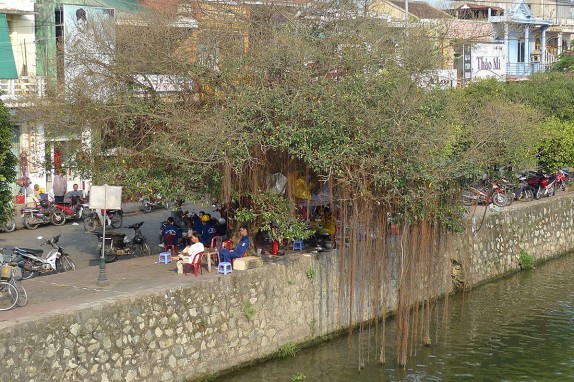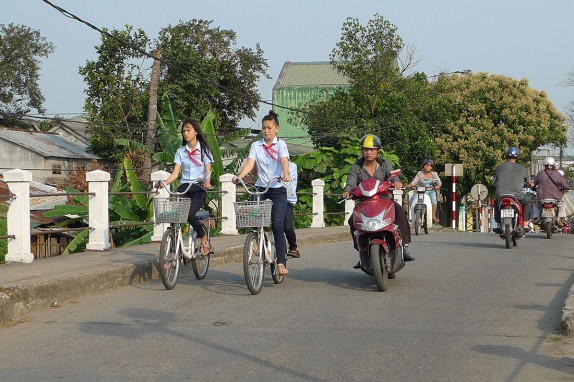 Huê´ is a beautiful city that on one hand seems to have changed little since the Citadel was constructed in the 1830s. With a patchwork of leafy parks, tree-lined streets, and a sophisticated network of canals and moats, it provides an incredible backdrop for the daily lives of some 60,000 residents that still live inside its walls. What is perhaps most memorable is the high level of activity that continues to occur out in the open, along streets and in public places. During the workshop I started the day with an early-morning bicycle ride or walk around the Citadel, and got to witness much of this life unfolding, from morning badminton matches and cheerful banter over ca phe sua da and pho at sidewalk cafes, to fishermen drawing in their nets and gardeners tending beds of water spinach.
Huê´ is a beautiful city that on one hand seems to have changed little since the Citadel was constructed in the 1830s. With a patchwork of leafy parks, tree-lined streets, and a sophisticated network of canals and moats, it provides an incredible backdrop for the daily lives of some 60,000 residents that still live inside its walls. What is perhaps most memorable is the high level of activity that continues to occur out in the open, along streets and in public places. During the workshop I started the day with an early-morning bicycle ride or walk around the Citadel, and got to witness much of this life unfolding, from morning badminton matches and cheerful banter over ca phe sua da and pho at sidewalk cafes, to fishermen drawing in their nets and gardeners tending beds of water spinach.
City officials at the Huê´ Monuments Conservation Center (HMCC) have been hard at work to preserve the framework that supports this life and to maintain and restore many of Huê´’s World Heritage monuments, including much of the Citadel, the Purple Forbidden City palace complex within, and the imperial tombs along the Huong (Perfume) River upstream.
But modern Huê´ is much more than just the Citadel and its monuments—it is a living and breathing city of 350,000 people that is rapidly changing. Just across the Huong river new buildings—nine or ten stories tall—were under construction along wide avenues, in stark contrast to traditional shophouses and garden houses. Scooters and motorcycles seem to have taken over streets en masse where just a few years ago bicycles were the vehicles of choice. Significant growth is expected. As we learned during the workshop, a series of proposed planning amendments to the City’s Management Plan would in sum double the land area of the city, potentially accommodating hundreds of thousands of new residents.
 What does this growth mean for the historic character of Huê´? The HMCC is charged with preserving and maintaining the world heritage monuments, and recognizes that Huê´ might need to plan its future carefully. HMCC staff characterized four “zones” that concern them when thinking about the preservation of Huê´’s World Heritage. First and perhaps most straightforward are the monuments themselves; after that, things quickly get complicated. Natural landscapes that surround these monuments are increasingly subject to development pressure. Tourist infrastructure is crucial to providing revenue, but needs to be planned and designed carefully to not have a negative impact. And the monuments are surrounded by neighborhoods and villages occupied by local people engaged in a variety of activities. As the city grows and changes, these four elements need to be considered and balanced together.
What does this growth mean for the historic character of Huê´? The HMCC is charged with preserving and maintaining the world heritage monuments, and recognizes that Huê´ might need to plan its future carefully. HMCC staff characterized four “zones” that concern them when thinking about the preservation of Huê´’s World Heritage. First and perhaps most straightforward are the monuments themselves; after that, things quickly get complicated. Natural landscapes that surround these monuments are increasingly subject to development pressure. Tourist infrastructure is crucial to providing revenue, but needs to be planned and designed carefully to not have a negative impact. And the monuments are surrounded by neighborhoods and villages occupied by local people engaged in a variety of activities. As the city grows and changes, these four elements need to be considered and balanced together.
From a planning perspective, the HMCC designates a “restricted zone” around each of the monuments (much in the same way that we might designate an historic landmark) and a “buffer zone” where the interplay of the four above elements is expected to occur. While the restricted zone is very straightforward, it’s hardly ever clear exactly how the buffer zone should be delineated, nor what exactly should occur within it.
This turned out to be a primary issue in the workshop: What exactly is Huê´’s heritage, and how should it be preserved? Is it enough for Huê´ to preserve its monuments, if its historic character changes everywhere else? Where is the balance between preservation of the monuments’ context and growth and change in the city? What other factors need to be considered when making planning and design decisions?
We led five interdisciplinary teams that focused on urban design with these larger issues of heritage preservation in mind. Two teams looked at the larger region and the Huong River, while four teams focused on local planning areas—each with their own historic value—that are confronted with significant pressure to change. As we quickly learned, Huê´ is also confronted with some pretty serious environmental factors, and is only beginning to think about the impacts of climate change and sea level rise. In my next post, I’ll talk a little about how these ideas of heritage preservation and environmental protection can work together.